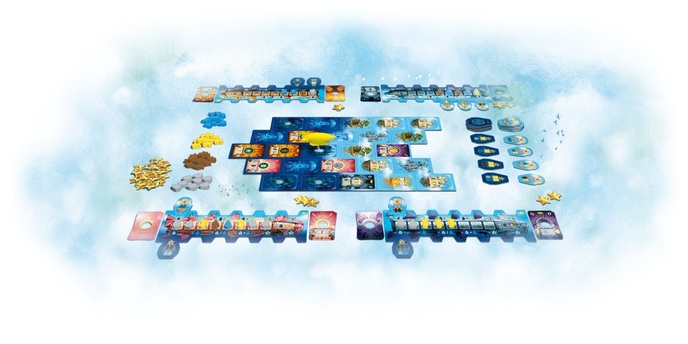
Designer Sebastian Dujardin runs the small Belgian imprint Pearl Games, but is probably better known to tabletop gamers as the designer of 2011’s Troyes, a medium-heavy game of worker placement and dice-rolling set in the Middle Ages, and a highly-rated game that is a little too familiar thematically. (Really, do we need more games about building cathedrals and deploying workers in medieval Europe?) He’s been mostly quiet on the design front since Troyes’ release, but is back with two new games this year, including the just-released Solenia, a lighter, fast-playing game of hand management and pattern matching with a board that moves and flips as you play.
Solenia has a bit of a disadvantage for new players because it looks like there’s a lot going on here: you have hand cards, a variable board with lots of symbols, four resource types (yep, once again, we’re collecting wood), and balloon tokens for delivering resources for points. Each player has their own deck of cards, with all decks identical but shuffled so your hand of three cards will likely always differ from what other players hold, and those cards have circular holes in the middle so when you play one on the board it reveals the resource that space provides. Your cards have the number 0, 1, or 2 on the top, and you get that many of the resource on the space where you play a card, or, if you play to a city space, that many bonus points (stars). The board itself has five strips of five spaces each, with one showing dusk/dawn and the others showing day on one side and night on the other. If you played a 0 card, you move the airship at the center of the board, which means you’ll take the lowest end piece of the board (behind the ship), resolve all player cards on its five spaces, flip the strip, and place it on the front of the board. If you played to a city space, you then must deliver resources from your board to fulfill one of the six contracts available on the balloon tiles, matching day or night depending on the space to which you played.
Thus playing a card to the board usually means you’ll collect something for it twice: once when you play, and again when its board strip reaches the end and is flipped. Those rewards in the latter case can just include more resources or more points, or can grant you a bonus point if you matched the card’s shown resource type on the bottom to the resource shown through the hole in the card. After the card is resolved, it’s discarded for the remainder of the game, so each player gets a fixed number of turns, playing each card in their deck exactly once.
Each player has their own board that they use to store resources—up to 8 in the standard game, up to 6 in the advanced game with ways to increase your storage as you play—and where they’ll place tiles for contracts they’ve fulfilled. Each time you place one of those tiles, you get a reward; early in the standard game, it’s just one resource, but if you complete five day contracts or five night contracts, you get 5 bonus points. You can also score at game-end for completed pairs of day/night contracts, scoring 1/3/6/10 points for up to four such pairs. In the advanced game, using the other side of the player boards, the bonuses are even more significant, such as one ‘free’ water resource on every turn for the rest of the game. The advanced side also lets players customize their boards slightly at the start of the game through a draft of improvement tiles, which either give you a unique power/ability for the entire game, or give you a significant point bonus for something at game-end that should in turn help determine your strategy during the game. Although it’s best for players who’ve played Solenia a few times, it improves the game significantly by testing how well players can fine-tune their decisions to match the specific changes to their player boards.
The bulk of the points you’ll get in Solenia come from those contracts; they’re worth 2 to 9 points, and we found we’d typically finish 5 to 7 contracts each. You’ll add points from your board plus any bonus points you picked up along the way to get to your total. Solenia games only take about a half an hour because turns are so short and the number of decisions you can make is somewhat limited—you’ll have three cards in hand, and you have to place a card adjacent to one of your cards already on the board or adjacent to the airship unless you want to pay extra resources to move further away. It works with two players, although you won’t step on each other’s toes very much and can easily pivot if, say, the other player fulfills the contract you were after. With more players, there’s more direct competition for spaces on the board and to finish a contract before someone else gets it. It’s a light game, a bit more than just a gateway title but still quick to learn, and better than much of the filler that occupies that niche in the market—especially once you’ve got the hang of it and can use the advanced side of the boards to crank up the difficulty level a notch.
Keith Law is a senior baseball writer for ESPN.com and an analyst on ESPN’s Baseball Tonight. You can read his baseball content at search.espn.go.com/keith-law and his personal blog the dish, covering games, literature, and more, at meadowparty.com/blog.
